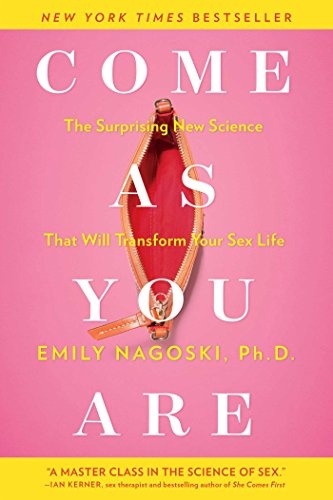Book Review: Come As You Are by Emily Nagoski
- Posted on
- By Cassie S on Smart Bitches Trashy Books

Come As You Are: The New Science That Will Transform Your Sex Life is interesting and informative. It’s a solid Sex 101 book.
I learned some new things from reading it and I got a better understanding of some things that I kinda sorta knew but didn’t fully understand. I also found it entertaining and accessible, and very body and sex positive.
The book consists of the main text, which explains different concepts and elements of sexuality, plus some exercises at the end of each section. There are also some couples who share their experiences throughout the book. I found this to be clunky because the couples are composites of many different people, and so their dialogue feels stilted and artificial, which is especially awkward because their purpose is to give a feeling of authenticity and immediacy to the issues discussed in the main part of the text. Generally though, the book is well-organized and readable.
The essential thesis, which repeats several times, is that when it comes to our reproductive organs and our sexual desires and behaviors, people are all made of the same stuff that is organized along roughly the same lines but includes infinite and perfectly healthy variation.
If you only take two things away from this book, take these two quotes, which are presented right at the beginning and then discussed in different contexts throughout the text:
Everyone’s genitals are made of the same parts, organized in different ways. No two are alike.
Are you experiencing pain?
If so, talk to a medical provider.
If not, then your genitals are normal and healthy and beautiful and perfect just as they are.
This message of acceptance of differences is repeated in more general forms throughout the book, as in this passage, in which the author reminds us not to “yuck somebody’s yum:”
Treat cultural messages about sex and your body like a salad bar. Take only what appeals to you and ignore the rest…it only goes wrong when you try to apply what you picked as right for your sexuality to somebody else’s sexuality.
“She shouldn’t eat those beets; beets are disgusting.”
They might be disgusting to you, but maybe she likes beets. Some people do. And you never know, maybe one day you’ll try them and find you like them. Or not, that’s cool, too. You do you.
And in a chapter about orgasms:
Just as all vulvas are normal and healthy just as they are, so all orgasms are normal and healthy, regardless of what kind of stimulation generated them or how they feel. Their value comes not from how it came to be or whether it meets some arbitrary criteria but from whether you liked it and wanted it.
Other key messages include the idea that your body’s reactions and your brain’s reactions don’t always match. Vaginal lubrication, for instance, does not always equal arousal and certainly does not equal consent. Context is everything – an affectionate touch from a partner at bedtime might mean a completely different thing to your brain than the same touch in, say, the middle of a traffic jam when you need to concentrate. Even an orgasm can be something that is not always pleasurable: “Pleasure is the perception of a sensation, and pleasure is context dependent.”
The author specifies that this book is primarily for and about cisgender women, not because trans women aren’t fully women (the author quite specifically states that they are) but because this is a science-based book and the science on trans women and sexual pleasure is limited. She mentions asexuality in a footnote in which she states, “Again, there’s nothing broken or wrong; asexual people’s sexual response mechanisms are made of all the same stuff as sexual people’s, they’re just organized in a different way.”
The book talks a lot about how experiencing trauma, especially sexual assault, affects people, and how myths about sex are harmful, for instance:
You know by now that bodies don’t say ‘yes’ or ’no’, they only say, ‘that’s sexually relevant’ without any comment on whether it’s appealing, much less whether it’s wanted.
With no further ado, here are the pros and cons of the book in my experience:
Pros:
This is a body affirming, sex positive book that celebrates the infinite healthy variation in our desires and our bodies.
This is an information-rich book that told me several things I either didn’t know or knew but did not fully understand in a well-organized, easy-to-understand, and entertaining format.
The author’s viewpoint is non-judgemental within a context of enthusiastic consent.
The author clears up several myths about sexuality and about women’s bodies and explains why these myths are harmful and dangerous.
Cons:
The book didn’t have cons so much as understandable limitations in scope. As a book that offers an overview of sex and orgasm, the book can only cover so much lest it turn into the War and Peace of books about sex. Accordingly, the book does not directly address the challenges that may face transwomen, women with chronic pain or disability, and women experiencing menopause. It’s understandable that these topics are left out, but readers should know ahead of time that the book is, by its own admission, primarily for and about able-bodied, cis-gendered women who are not going through menopause. It’s not that people in these categories can’t benefit from this information. It’s just that any needs they may have are not directly addressed here.
I’d suggest this book as good for people who want to know about cis female anatomy, biology, culture, and orgasm. You don’t have to have any knowledge about sex and orgasm to keep up, and I found my understanding of something I had known about but not fully understood was deepened. It’s a solid, entertainingly written book that gives science-based advice about happy sex and orgasm.
